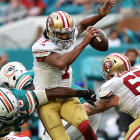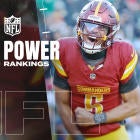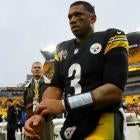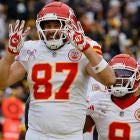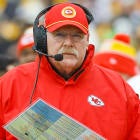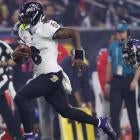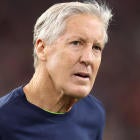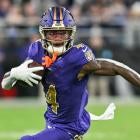We haven't seen Colin Kaepernick in an NFL game since 2016, and the league and this country have undergone significant changes since.
With a recent surge in the likelihood Kaepernick will actually return to the NFL this season, it's time to talk strictly football about the country's most famous athlete activist for racial injustice. These are my scouting takeaways after watching his 2016 season as the starting quarterback for the 49ers.
Strengths
As of 2016, Kaepernick was still a dangerous scrambler and designed-run quarterback. He accumulated 468 yards on the ground and averaged a career-best 6.8 yards per carry that season.
At 6-foot-5 and over 230 pounds with 4.53 speed (at the 2011 combine) he eats plenty of ground with long strides, making him a deceptively fast ball carrier.
Per Sports Info Solutions, he took 22 designed runs for 127 yards (5.77 yards per), which means he scrambled 47 times for a whopping 341 yards for a bulky 7.25 yards per carry. That season, Kaepernick tied Tyrod Taylor for most runs of 10-plus yards with 22. He was dangerous with his legs.
While Kaepernick's delivery is more sidearm to three-quarters than over the top like the majority of quarterbacks, his arm was still very live in 2016. He was capable of making long throws while on the run or off balance, and ripping it through a tight window -- if he found one -- was no problem.
Because of his combination of imposing size, high-end athletic traits, and a rocket arm, Kaepernick actually performed pretty well under pressure in 2016. Per SIS, 60 of his 95 attempts while under duress were on target (63.1%), and while he averaged just 6.26 yards per attempt under pressure, Kaepernick tossed five touchdowns with no interceptions in such situations.
In general, he took good care of the football, only tossing four interceptions -- with seven adjusted interceptions per Football Outsiders, a stat that counts when passes should be intercepted along with picks that aren't a quarterback's fault. His adjusted interception rate was a paltry 1.1% in 2016.
Weaknesses
With Kaepernick, it typically wasn't pretty or by the book.
There were rare occurrences when he demonstrated the polished skill of subtly drifting away from pressure while staying inside the pocket before throwing accurately down field. In most occasions, when Kaepernick didn't like what he initially saw, he'd freestyle to avoid pressure, typically escape out of the pocket one way or the other before either taking off or throwing on the run.
And a decent portion of those throws looked uncomfortable or awkward upon delivery because his overt trust in his arm provided a willingness to make off-balance tosses. At times, due to his raw abilities, he got away with passes that lacked fundamentals, yet many times the intercepted passes or defended passes -- and there were plenty of the latter -- came in those technically unsound moments.
While Kaepernick wasn't strictly a one-read-then-run quarterback, calmly moving through his progressions wasn't his forte. It was when conventional coaching wisdom would've told him to stay poised and get through his reads that he usually got antsy and went completely off-script. His accuracy wasn't a major problem but was far from pinpoint. Per SIS, his on-target rate of 80.3% was 22nd among the 30 quarterbacks who threw at least 250 passes that season. His Intended Air Yards were 8.5 in 2016, a middle-of-the-pack figure, according to Next Gen Stats. His film showed a good mix of deep shots and swing passes/checkdowns underneath along with a plethora of slants off quick play-action, some of which looked like RPOs.
Supporting Cast
In 2016, Kaepernick's 49ers looked considerably different from the team that went to the NFC title game three years previous (and the Super Bowl at the end of the 2012 campaign). And it was a club with not nearly as much talent as today.
He primarily targeted pass catchers like 27-year-old Torrey Smith, 28-year-old Jeremy Kerley, and tight end Garrett Celek. Secondary targets included Rod Streater, Vance McDonald, and Aaron Burbridge. His running backs were Carlos Hyde and Shaun Draughn. Far from a threatening group.
The tackles were solid -- Joe Staley and Trent Brown -- but the interior of the line was lackluster featuring Zane Beadles, Daniel Kilgore, and eventual first-round bust Joshua Garnett. The 49ers had one of the least-imposing offensive groups in football that season. Besides a few splash plays downfield from Smith, Kaepernick's supporting cast rarely helped him.
Summary
Kaepernick was solid albeit mostly unspectacular in his 11 games as San Francisco's starter. Altogether, he completed 59.2% of his throws (196 of 331) with 16 touchdowns and four picks at 6.8 yards per attempt. The 49ers were one of the worst teams in football, finishing 2-14 and securing the No. 2 overall pick in the 2017 draft.
San Francisco's massive team struggles and his freestyle-based play at the quarterback spot collectively made for an easy crutch for team decision-makers to justify not signing him after he opted out from his contract with the 49ers when Kyle Shanahan arrived during the 2017 offseason.
But quarterbacking in the NFL looks much different than it did 2016, a time when methodical, mostly non-athletic pocket passers ruled the league and, while fun, improvisation at the position was mostly deemed as a sign of rawness and carried a negative connotation instead of being embraced like it is becoming today.
The top 10 in quarterback rating in 2016 was as follows: Matt Ryan, Tom Brady, Dak Prescott, Aaron Rodgers, Drew Brees, Sam Bradford, Kirk Cousins, Derek Carr, Andrew Luck, and Marcus Mariota -- a top-tier contingent predominately consisting of mostly stoic pocket passers.
Heck, the new wave of ultra-athletic quarterbacks with ad-lib specialties Patrick Mahomes, Lamar Jackson, Deshaun Watson, and Josh Allen weren't even in the league yet. Because of the paradigm shift currently happening at the league's most important position, Kaepernick actually fits in the NFL better now than he did in 2016.
Assuming he hasn't lost much athletic talent and could shake off rust as a passer rather quickly, he has a high-end backup skill set, and it wouldn't be preposterous to envision him being the main reason his team won a few games as a spot starter in 2020. Heck, just two years ago, Mitchell Trubisky, a quarterback with less natural talent than Kaepernick but some stylistic similarities to him, had six games with a quarterback rating over 100 on a 12-4 Chicago Bears team.









